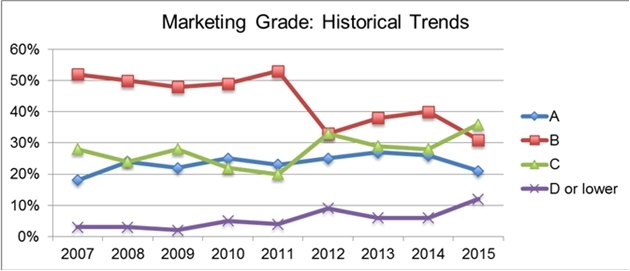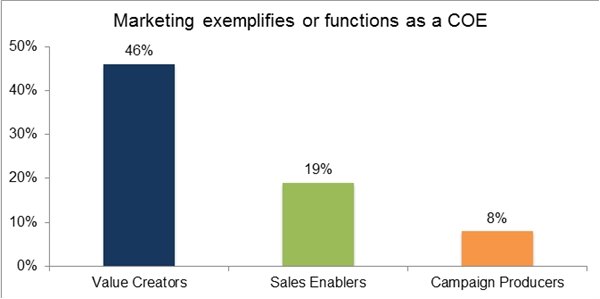Finance leaders identified marketing efforts, or expanding relationships with existing customers, as the top strategic factor driving company growth and profitability in 2016, according to the 6th annual CFO Sentiment Study. Nevertheless, marketing budgets are already on the chopping block.
For example, to support Unilever's efficiency expansion drive, its marketers will now have to adopt "zero-based budgeting": They'll have to justify spending on all new activity instead of their budgets' being based on the previous year's spending.
What might be the underlying cause of budget reductions despite CFOs' belief that both top-line and bottom-line growth in 2016 will require sales and marketing? It's likely that despite improvements in technology and processes, as well as an increased focus on measurement, only few marketers can actually prove their value.
Marketing Performance
Since 2001, the annual Marketing Performance Management (MPM) Benchmarking survey has asked a pivotal question to facilitate comparison of the study's insights: "What grade would the C-Suite give the marketing organization for its ability to demonstrate its value and contribution to the business?"
Study data collected over more than a decade has revealed three marketing performance personas related to the C-Suite grade:
- The A's: The more strategic and data-driven marketers who primarily focus on how to create value for customers and the business. This best-in-class group leads all others in terms of performance. They are identified as Value Creators.
- The B's: This group sees its primary role as serving the sales team. These marketers' focus is on demand generation. They constitute the middle of the pack in terms of performance, and they are identified as Sales Enablers.
- The C's and D's (or lower): This group operates as a service provider or internal agency to the organization, producing marketing outputs as scheduled as well as on demand. Compared with other marketing organizations, they constitute the Laggards in terms of performance, and they are identified as the Campaign Producers.
While the pressure and the investment in technology to support performance measurement management is increasing, the percentage of marketers able to prove their value and contribution and achieve excellence is decreasing.

Figure 1: The percentage of marketers achieving excellence is decreasing
Centers of Excellence
The same group of surveyed CFOs says business agility is critical to realizing top-line revenue and overall growth. Forrester defines business agility as "the quality that allows an enterprise to embrace market and operational changes as a matter of routine."
Agility and Centers of Excellence (CoE) go hand-in-hand. Organizations that achieve agility excel at fostering and harnessing best-practices. They achieve excellence.
The MPM study finds that in addition to being able to prove their value, only the best-in-class marketing organizations are making headway at operating as a Center of Excellence. The Value Creators are almost six times more likely to operate as a CoE than are the Campaign Producers. Almost half of Value Creators exemplify the characteristics of, or function as, a CoE; less than 20% of Sales Enablers and less than 10% of Campaign Producers do so.

Figure 2: Almost half of the best-in-class marketers exemplify the characteristics of, or functions as, a Center of Excellence
A CoE provides the leadership required to foster best-practices, facilitate research, and enhance the skills needed to drive business results. It provides the entire organization with visibility into quality and performance parameters and helps the organization employ best-practices to improve internal business processes, customer-centricity, market leadership, and market innovation.
A marketing organization that is serious about driving a consistent approach needs to establish and document its set of practices and standards. This is essentially the work of a CoE:
- Define a common set of best-practices and work standards.
- Guide and assist either directly or through instructional content, tools, templates, etc. in the implementation of those best-practices and work standards.
- Develop a governance process for those practices and standards.
Four Steps for Embarking on Your Marketing CoE Initiative
- Secure executive sponsorship. An executive sponsor will enable the marketing CoE to succeed and thrive. With "skin in the game," they will ensure that the processes and best-practices permeate the organization—and essential element of realizing the full potential of this initiative.
- Define goals and success criteria. Early and absolute clarity about purpose, what constitutes success, and what measures will be employed is pivotal to success and will be the only way to monitor progress.
- Establish organizational structure and process framework. It is important to determine who is going to lead the Marketing CoE, how your CoE is going to run, and the individual team member roles. Define and document the processes associated the operation of the CoE.
- Establish a change-management process. Areas of improvement or business opportunities are the catalyst for a CoE. Hence, by its very nature, it is an entity of change. The CoE will need to take change management into account as part of having its work adopted by the broader organization.
Developing a marketing CoE, any CoE for that matter, takes energy, resources, and time. Why do it? Because it can provide a platform for alignment, quality improvement, and reduced costs while improving market differentiation and higher customer satisfaction. The purpose of a CoE is to develop standardized, evidence-based processes that ensure your organization's ability to quick adapt and produce high-quality outcomes, such as better customer experiences.
* * *
Back to the CFOs in the study: CFOs say company success this year will be defined in large part by the ability to expand relationships with existing customers, the relative effectiveness of marketing efforts, and operational efficiency.
Marketers, now is not the time to be risk-averse. To hold on to your budget and your resources, it's time to help your organization improve both top-line and bottom-line growth. In turn, that will require you to execute, to understand your addressable markets like never before, and to expand and harness relationships with current customers. All that is the very essence of a marketing CoE.
(If you're ready to create or expand marketing as a CoE, learn more about creating a marketing center of excellence with our new whitepaper, What You Must Know About Marketing Centers of Excellence: A Why and How Primer.)




